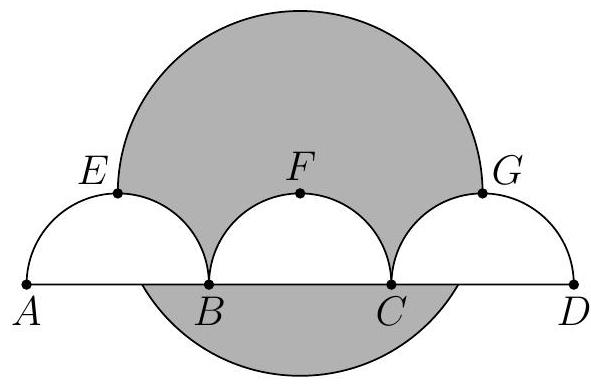Problem:
As shown in the figure, line segment is trisected by points and so that . Three semicircles of radius , and , have their diameters on , and are tangent to line at , and , respectively. A circle of radius 2 has its center on . The area of the region inside the circle but outside the three semicircles, shaded in the figure, can be expressed in the form
where , and are positive integers and and are relatively prime. What is ?

Answer Choices:
A.
B.
C.
D.
E.
Solution:
Divide the circle into four parts: the top semicircle by connecting , and ; the bottom sector , whose arc angle is because the large circle's radius is and the short length (the radius of the smaller semicircles) is , giving a triangle; the triangle formed by the radii of and the chord ; and the four parts which are the corners of a circle inscribed in a square . Then the area is (in , we find the area of the bottom shaded region, and in we find the area of the shaded region above the semicircles but below the diameter).
The area of is .
The area of is .
For the area of , the radius of 2 , and the distance of 1 (the smaller semicircles' radius) to , creates two triangles, so 's area is .
The area of is .
Hence, finding , the desired area is , so the answer is .
OR
First we have to solve the area of the non-shaded area(the semicircles) that are in Circle . The middle semicircle has area and the other two have about half of their are inside the circle . Then we subtract the part of the quartercircle that isn't in Circle . This is an area equal to that of a triangle minus an minor segment. The height of the triangle is the radius of the semicircles, which is . The length is the radius of Circle minus the length from the center of the middle semicircle up to until it is on the edge of the circle. Using the Pythagorean Theorem we can figure out that the length is:
=
This means that the length of the triangle is and so the area of the triangle is . For the area of the segment, it's the area of the sector minus the area of the triangle. The triangle's length is the radius of : , while its height is the radius of the semicircles: , so the area is . The angle is as the hypotenuse is the radius of and the opposite side is the radius of the semicircles, which means the area is of the whole area, which is so the area of the sector is and the area of the segment is and so the area of the part of the quartercircles that stick out of Circle is:
= =
Since there are two, one for each side, we have to multiply it by , so we have , which we subtract from which gets us which we subtract from , which is so we get .
The problems on this page are the property of the MAA's American Mathematics Competitions